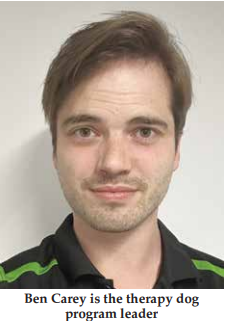
Animals reduce pain, anxiety and stress
If you are a patient at the Saskatoon Community Clinic and pop in for, say, a test on a Thursday morning, there might be a dog treat waiting for you. His name is Mr. Mugz. We’re not sure about his breed: a “Shiatzu-Bassett-hound-maybe-spaniel because he points,” says his handler, owner and best friend, Koreen Geres. “He’s a character.”

Mr. Mugz is one of approximately 50 therapy dogs trained and signed up with St. John Ambulance in Saskatoon, which runs the program in Saskatchewan. There are also about 60 dogs in Regina and 10 to 15 in smaller centres around the province. These gentle animals appear at a variety of locations ranging from medical centres, hospitals and care homes to corrections facilities. And their numbers, post-COVID, are on the rise.
“We’re really proud,” said Ben Carey, provincial coordinator of community services for St. John Ambulance. “Our numbers were very low after COVID. Dogs aged out or passed away; and people weren’t able to come back to volunteering. “We’ve been recruiting all the time, running lots of evaluations.” It’s a lot of work, and the evaluation process is very tough, he said. “Right after COVID, not a lot of dogs were able to pass because they weren’t able to socialize during COVID. It’s not the dogs’ fault at all; it was just the circumstances of the time. “We had a lot of trouble getting new dog teams after COVID but in the last year we’ve been doing such a good job. We’ve been recruiting a lot.” Geres joined the program in spring 2022 with her first dog, Boo, an Old English bulldog, with whom she did a visit at Corrections. “When Boo and I went out to the jail, the guys were so responsive. And you know, these are tough, tough guys. They’ve had tough lives, and they’re not incarcerated for no reason, usually. And they were gentle and respectful of me and the dog. They were so kind, so responsive. “And they wanted to talk about their dogs, the dogs they had left at home or dogs they had in the past, or their kids with dogs. My heart was just bursting with empathy.”

Sadly, she lost Boo shortly thereafter. “He was just the perfect dog, but he got sick and died,” Geres said. “It was so sad. I was so lonely without him I wanted to get another dog, and that was October, but I was sick and couldn’t go to SPCA, so my kids went, and they Facetimed me and said, what do you think of this one, Mom? And it was Mr. Mugz.” Her main instructions were that the dog had to be calm, quiet, and could fit through a Bassett houndsized door. “They found him and he’s just perfect. Absolutely perfect.”
Geres became interested in the program after she retired and saw an interview on TV with Colleen Dell, PhD, an animal therapy researcher and practitioner with the University of Saskatchewan. Then she spoke to Darlene Chalmers PhD, an associate professor at the Faculty of Social Work on the Saskatoon campus, whom she met through International Women of Saskatoon, and who works with Dell. Geres was inspired. “My background is education, and I’ve worked with newcomer kids and trauma was really my area of interest in research. I was just interested in seeing what are some different ways we can approach or assist people who have had trauma.” Handlers must have a dog — a personal pet — for a year before taking the test to qualify for the therapy dog program, so there was a lag before she was able to resume her mission. “I was so anxious to get back out there again and see what we could do,” Geres said. “But Corrections wasn’t a good situation for Mugz because he’s an active guy. He wants to be on the move. He was just too restless. “When the call came out for Community Clinic, I thought ‘well, let’s give it a try and see.’ Who would imagine the dog in the clinic? It was the perfect place for us – lots of people moving around, we could go out if he needed to. “We’ve been there since last spring and it’s great. It’s the highlight of my week.” “I think it’s wonderful for the staff too. They have really bonded. Mr. Mugs loves it too. I say it’s time to go to work and he’s squeaking and very excited. He knows what ‘go to work’ means.”
Research proves the benefits Carey worked under Dell for five years doing studies into therapy dogs and other animal-human interactions. One of his projects was putting out a rental guide on housing and pets. “I continue to work with Colleen. We’re doing some fantastic work. One of the largest studies we did was a big pain study at the Royal University Hospital. We took in dogs, we visited over 100 people, and did a control side with another 100 people with and without the dogs. “We visited for 10 minutes, and then we left for 20 minutes, and after 20 minutes there was a lasting effect on reduction in pain, an increase in well-being, and a reduction in anxiety and depression.”
The program also partners with the One Health office, working on human-animal interactions and how they benefit all kinds of people: veterans, people struggling with substance addiction, and so on. “My research has shown the absolute benefit of people especially in their most vulnerable times. Basically, people get to visit with somebody that’s giving them unconditional love and support. “That’s what a dog does. A dog doesn’t judge you. It doesn’t care where you’re from. . . people really feel that, especially at their lowest. It just makes a world of difference.”
Most therapy teams, like Geres and Mugz, focus on certain locations, he added. “We find that’s a great way for them to do really amazing work, having consistent visits at one location so they can get to know the people, the people can get to know the dog. A lot of people come because the dog is there.” “Even if the dog isn’t there the next time, the dog was there the last time. People associate that place with there being a dog there.” They also found that when they attended the vaccination clinics during COVID, it had a big effect on a lot of kids because they had a lot less fear. Subsequently, “they found a reduction in needle fear regardless of whether there was a dog there.” There remains more demand than supply, but St. John is recruiting all the time. But joining the program is not a small thing. Handlers need a vulnerable sector test and references from friends, family and colleagues to vouch for them. Vaccination records for the animal must be provided. “They need to not be on a raw food diet because of a small chance of passing along e. coli and visits are with a lot of vulnerable people,” Carey added.
Then comes the big evaluation. The dogs are brought into a room with eight to 12 volunteers as well as things like crutches and wheelchairs, and there are loud noises “to make sure this dog can handle anything. The dog is allowed to be a dog but can’t be aggressive and can’t get really scared.” Sometimes, just bringing them back in a few months does the trick, and often they return as “fantastic therapy dogs.” Then, of course, the handlers need to step up as well. “The handlers have to be in there talking to people. When they’re in there, they’re controlling the dog. But it may want to jump up and cuddle, and you can’t do that with (some older people.)” St. John staff then go with the doghandler teams to their first visits or to a new facility, to make sure the dog is comfortable in that new space. While the St. John Ambulance Therapy Dog Program contingent is growing, Carey will continue to seek more teams “I want to see every care home that wants a dog, every school that wants a dog, to be visited by a therapy dog that wants one.”
Go to the website for more information if you want to become a therapy dog team member or are looking for a visit. https://sja.ca/en/ community-services/therapy-dogprogram.
– Joanne Paulson

Leave a Reply